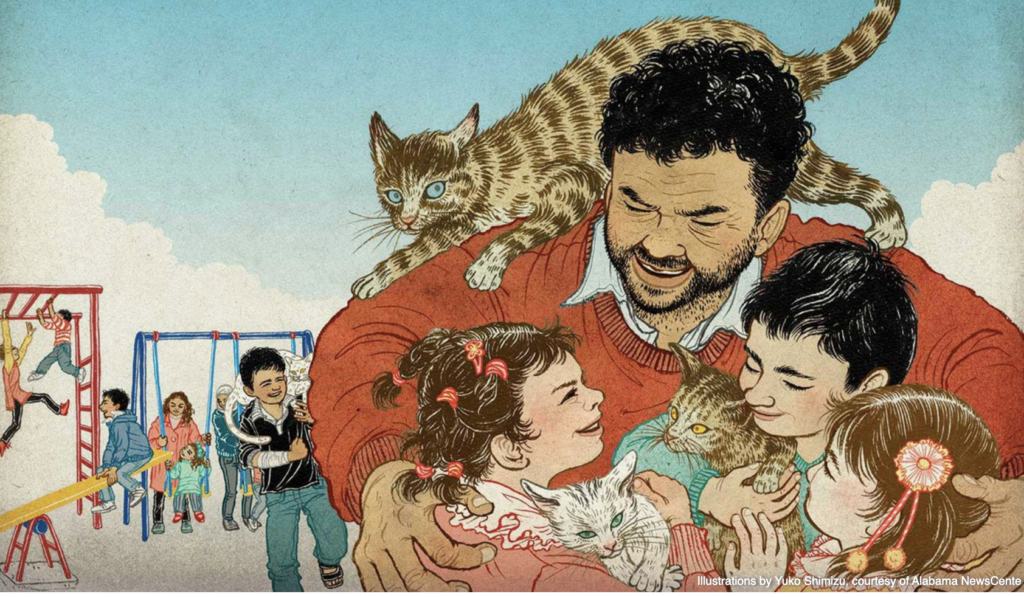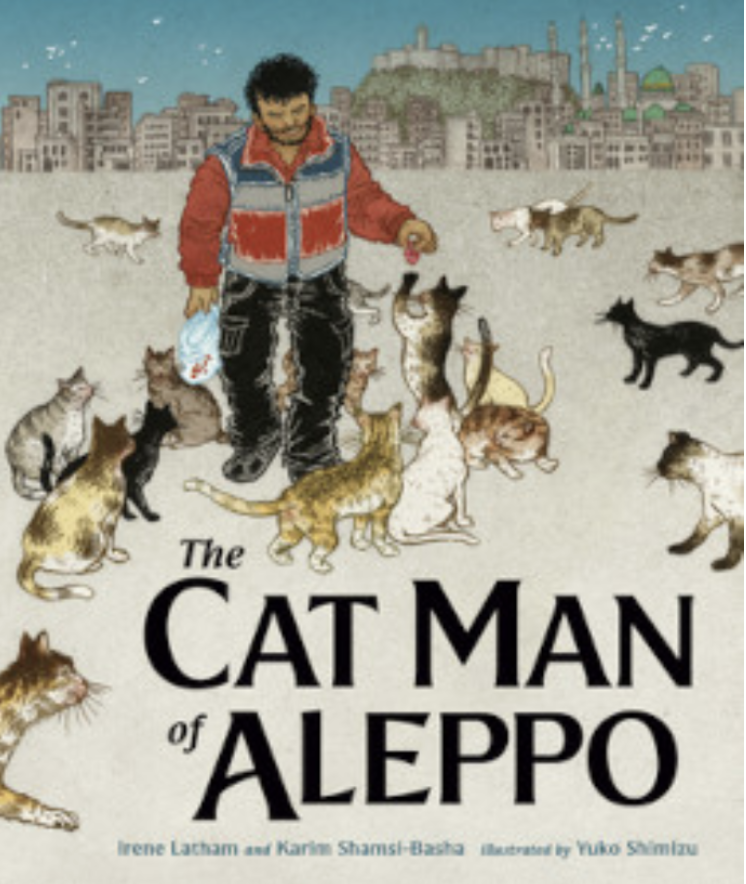A Heartwarming Children's Book: The Cat Man of Aleppo

By Arwa Almasaari / Arab America Contributing Writer
The Cat Man of Aleppo, written by Irene Latham and Karim Shamsi-Basha, with illustrations by Yuko Shimizu, is an inspiring and heartwarming picture book. It tells the true story of Mohammad Alaa Aljaleel, a Syrian ambulance driver who rescued people buried under rubble during the turmoil of the Syrian war. However, his heroism extended beyond humans.
After the city was abandoned, Alaa also began rescuing stray cats. His compassion led him to open a sanctuary for these cats and, eventually, a veterinary clinic and an orphanage next door that offers pet therapy to help heal the scars of war. Alaa’s extraordinary kindness and dedication make him a fitting subject for this beautifully illustrated, award-winning picture book.
Book Details

Author: Irene Latham & Karim Shamsi-Basha
Illustrator: Yuko Shimizu
Publisher: G. P. Putnam’s Sons
Awards: Caldecott Honor, Middle East Book Award, etc.
Hardcover | $18.99
Apr 14, 2020 | 40 Pages | 9 x 10-3/4 | 4-8 years | ISBN 9781984813787
How the Story Begins
The book opens with a vibrant depiction of a Syrian bazaar filled with busy merchants, happy shoppers, playful children, and curious cats. The city is full of life, and we see Alaa enjoying a chat with a merchant, holding a bag of dried fruits, and sampling a piece. The illustrations perfectly complement the text, which describes Alaa’s love for Aleppo and its people in simple, gentle, and calming words.
However, this sense of serenity is short-lived. On the next page, Alaa is depicted covering his face with his hands while a window behind him reveals smoke rising from a bombed building. The black background of the page, with only Alaa and the window visible, emphasizes his sadness. The following pages show him rescuing people as an ambulance driver, with illustrations that tastefully depict the city’s destroyed buildings and injured individuals in a manner suitable for young readers.
The Joy of Helping Living Beings
When Alaa spots stray cats on the next page and offers them food, the illustrations shift from dark to heartwarming. This focus on stray cats needing shelter, food, and love instead of on humans serves a dual purpose. First, it distances children from the disturbing effects of war on people. Second, it helps them understand that all living beings deserve our compassion.
The story also depicts Alaa sharing his experiences on social media. Thanks to the kindness of strangers worldwide, he was able to shelter, feed, and care for stray cats and other animals in a large sanctuary. He also built playgrounds for children, emphasizing the importance of caring for both humans and animals. The illustrations effectively convey Alaa’s joy in bringing happiness to those around him.
Personal Thoughts
When I first heard about this book, I was skeptical. How could a story with war in the background not be too dark for young readers? How could a child relate to a story about an adult? Would the illustrations be another distorted and Orientalist depiction of an Arab town? Reading the book transformed me from a skeptic into a believer. The theme of war was not overbearing; Alaa was relatable, with his youthful spirit and innocent heart. Finally, the illustrations of Aleppo were realistic enough to evoke my desire to revisit Syria.
Authenticity and Illustration
The collaboration between children’s book author Irene Latham and Syrian-born photographer and writer Karim Shamsi-Basha added authenticity to the story, especially with the inclusion of a few Arabic words. The Japanese illustrator Yuko Shimizu intrigued me and led me to research her. Shimizu is the original designer of the famous Sanrio character, Hello Kitty. It’s no surprise that this multi-award-winning illustrator beautifully captured the heart and soul of Aleppo. You can almost hear the merchants in the bazaar chatting with their customers, the laughter of children playing near their parents, and the stray cats purring as passersby gently pet them.
A Small Concern
My only concern with the book is the authors’ choice to refer to the protagonist by his middle name, “Alaa,” rather than his first name, “Mohammad.” Given the mainstream media’s history of depicting negative characters with Muslim-sounding names, it is important to use a name like Mohammad for a kind, loving, and generous protagonist. Providing positive role models for underrepresented communities is crucial, and using the protagonist’s full name could contribute to this effort.
The Power of Compassion
This heartwarming story encourages readers, both children and adults, to show sympathy even in the darkest moments. Alaa’s big heart saved children and cats and lifted him from feelings of helplessness, sadness, and loneliness in a war-ravaged town. The Cat Man of Aleppo is a testament to the power of compassion and the impact one individual can have, making it a must-read for all ages.
Arwa Almasaari is a scholar, writer, and editor with a Ph.D. in English, specializing in Arab American studies. She often writes about inspirational figures, children’s literature, and celebrating diversity. You can contact her at arwa_phd@outlook.com
Check out our blog here!








